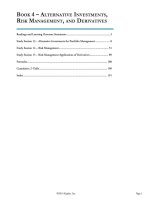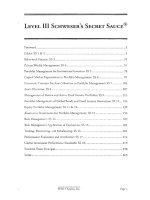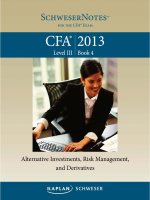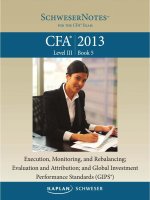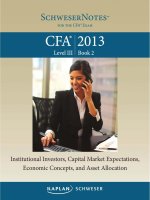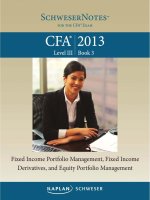CFA level 3 volume VI trading and rebalancing, performance evaluation, and GIPS finquiz smart summary, study session 16, reading 31
Bạn đang xem bản rút gọn của tài liệu. Xem và tải ngay bản đầy đủ của tài liệu tại đây (71.49 KB, 7 trang )
2018 Study Session # 16, Reading # 31
“EXECUTION OF PORTFOLIO DECISIONS”
MV = Market Value
IV = Intrinsic Value
TMG = Trade Management Guidelines
2. THE CONTEXT OF TRADING: MARKET MICROSTRUCTURE
Market microstructure ⇒ process that affects how trades are executed.
2.1 Order Types
Market Order
Limit Order
Requires prompt execution.
Price uncertainty.
Specific limit price for execution.
Execution uncertainty.
Additional Order Types
Market-Not-Held Order
Market on Open Order
Variation of the market order.
Not held means not to trade at any specific
price or time interval.
Executed at the opening of the market.
Market on close order ⇒ executed at market
close.
Participate (don’t Initiate) Order
To capture a better price, broker waits for &
responds to initiate more active trades.
Best Effort Order
Undisclosed Limit Order/Reserve/ Hidden Iceberg Order
Gives the trader’s agent even more discretion
to work the order.
Variation of a limit order.
Instruction not to show more than some maximum
unfilled order quantity.
Types of Trades
Principal Trades
Broker commits capital for the prompt
execution of the trader’s order.
Suitable when order size is large & more urgent.
Portfolio Trades
Order to trade a specific basket of securities.
Low cost strategy on a relative basis.
Copyright © FinQuiz.com. All rights reserved.
2018 Study Session # 16, Reading # 31
2.2 Types of Markets
2.2.1 Quote-Driven (Dealer) Markets
Trades are executed with a dealer.
Inside bid (ask) is the highest (lowest) bid (ask).
Closed-book market ⇒ where limit order book is
not visible to the public.
Dealer’s role:
Ensure market continuity.
Immediacy or bridge liquidity.
Suitable in markets requiring negotiation.
Some measures of trade costs:
Quoted bid-ask spread.
Effective spread.
Better representative of true cost
because it captures both price
improvement & market impact.
2.2.2 Order-Driven Markets
Public limit orders establish transaction prices.
Trade may be delayed or unexecuted (absence of
a dealer).
Traders can’t choose with whom they trade.
2.2.3 Brokered Markets
2.2.4 Hybrid Markets
Transactions take place through brokers away
from public markets.
These markets are suitable where:
Public markets are small.
Illiquidity.
Block transactions take place.
Combinations of the previously described market
types.
Example ⇒ NYSE (elements of batch auction,
continuous auction & quote driven markets).
Types of Order-Driven Markets
Electronic Crossing Networks
Auction Markets
Buy & sell orders are batched & crossed at a
specific point in time.
Benefits.
Avoid costs of dealers.
Avoid market impact.
Prevent information leakage.
Anonymity.
Low commissions.
Drawbacks:
Execution uncertainty.
No price discovery.
Orders of multiple buyers compete for execution.
Provide price discovery.
The problem of partial fill.
Batch action markets ⇒ trade occurs at a single
price pre specified point in time.
Continuous auction markets ⇒ trades occur at
any time during the day.
Electronic Limit-Order Markets
Computer based auctions that operate continuously within the day.
In contrast to crossing networks these:
Operate continuously.
Provide price discovery.
Like crossing networks, these:
Provide anonymity.
Are computer based.
Copyright © FinQuiz.com. All rights reserved.
2018 Study Session # 16, Reading # 31
2.3 The Roles of Brokers and Dealers
Brokers
Dealers
Agent of the investor who works for commission.
Provides following services:
Represents the order.
Find the opposite side of trade.
Supply market information.
Provide discretion & secrecy.
Supporting investment services.
Supports the market mechanism.
Adversarial relationship b/w the trader & a
dealer:
Difference in bid-ask spread preferences.
Adverse selection risk ⇒ risk of trading with
a more informed trader.
Buy side traders are often strongly
influenced by sell side trade.
2.4 Evaluating Market Quality
Liquidity
Transparency
Characteristics of a liquid market:
Low bid-ask spread.
Market depth ⇒ big trades do not tend to
cause large price movements.
Resilient market ⇒ small & quickly
correctable discrepancies b/w MV & IV.
Factors that contribute to a liquid market:
Many buyers & sellers.
Different types of market participants.
Convenience.
Market integrity.
Liquidity advantages:
Less price impact.
Suitable for information motivated traders.
Easy capital raised by corporations.
Pre-trade transparency ⇒ quick, easy,
inexpensive & accurate information about quotes
& trades.
Post trade transparency ⇒quick & accurate
details on completed trades.
Assurity of Completion
All parties to trades will honor their
commitments.
Clearing entities can help ensure assurity of
completion.
Copyright © FinQuiz.com. All rights reserved.
2018 Study Session # 16, Reading # 31
3. THE COSTS OF TRADING
3.1 Transaction Cost Components
Explicit Costs
Implicit Costs
Direct costs of trading.
These include commission, taxes, stamp duties &
fees paid to exchanges.
Bid ask spread.
Market impact ⇒effect of the trade on
transaction prices.
Missed trade opportunity costs ⇒arise from
failure to trade in a timely manner.
Delay costs ⇒ inability to trade immediately due
to size & liquidity.
Measurement of Costs
Implicit costs are measured against some price benchmark:
One benchmark is the time-of-trade mid quote.
Opening & closing prices (less satisfactory).
VWAP (when price information is lacking).
Most exact approach ⇒ implementation shortfall.
VWAP
Volume weighted Average price at which
the security traded during the day.
Advantages
Disadvantages
Easy to compute & understand.
Best for comparing smaller trades in nontrending markets.
Can be computed quickly.
Ignores slippage & missed trade opportunity
costs.
Subject to gaming by delaying trades.
Can be misleading.
Not sensitive to trade size or market conditions.
Implementation Shortfall Approach
Definition
Advantages/Disadvantages
Difference b/w money return on a paper portfolio & actual
portfolio’s return.
Decision price is used for paper portfolio.
Captures explicit & implicit elements of transaction costs.
Four components:
Explicit costs.
Realized profit/loss.
Slippage cots.
Missed trade opportunity costs.
Implementation shortfall is adjusted for market movement
through market model.
Advantages
Relate cost to the value of
ideas.
Recognizes tradeoff b/w
immediacy & price.
Allows attribution of
costs.
Not subject to gaming.
Copyright © FinQuiz.com. All rights reserved.
Disadvantages
Require extensive data.
Unfamiliar evaluation
framework for traders.
2018 Study Session # 16, Reading # 31
3.2 Pre-trade Analysis: Econometric Models for Costs
Used to build reliable pre-trade estimates.
According to market microstructure theory, trading costs are non-linearly
related to these factors:
Stock liquidity characteristics
Risk
Trade size relative to available liquidity
Momentum
Trading style
Estimated cost function can be used:
To assess execution quality.
Appropriate trade size to order.
4. TYPES OF TRADERS ANDTHEIR PREFERRED ORDER TYPES
4.1 The Types of Traders
Information-Motivated Traders
Act on information that has limited value if
delayed.
Focus on liquidity & speed of execution.
Market orders & large block trades.
Value-Motivated Traders
Act on value judgments based on research.
Price focus & infrequent trading.
Use limit orders.
Sometimes act as a dealer’s dealer.
Liquidity-Motivated Traders
Counterparties to more knowledgeable traders.
Do not want to reap information advantage.
Time preference.
Use market, market not held, best efforts,
participate, principal traders, portfolio trades &
orders on ECNs & crossing networks.
Passive Traders
Much more concerned with cost of trading.
Price preference.
Use limit orders, portfolio trades & crossing
networks.
Avoid large as well as heavily concentrated
orders.
5. TRADE EXECUTION DECISIONS AND TACTICS
5.1 Decisions Related to the Handling of a Trade
Small, liquidity trades ⇒ executed via direct market access &
algorithmic trading.
Large information laden trades ⇒ executed via skills of senior
traders.
Copyright © FinQuiz.com. All rights reserved.
2018 Study Session # 16, Reading # 31
5.2 Objectives in Trading and Trading Tactics
5.2.1 Liquidity-at-Any-Cost Trading Focus
Used by information traders who trade in large
block sizes & demand immediacy
Attract high commission rate brokers.
Use expensive methods for timely execution.
5.2.3 Need-Trustworthy-Agent Trading Focus
To execute large orders in thinly traded issues.
Use of skillful brokers by placing a best effort,
market not held or participate order.
Trader loses control of the trade.
5.2.2 Costs-Are-Not-Important Trading
Market orders.
Ordinary spreads & commission for speed of
execution.
5.2.4 Advertise-to-Draw-Liquidity Trading Focus
Used for IPOs, secondary offerings & sunshine
traders.
Risk of front running.
Little or no market impact if sufficient number of
traders.
5.2.5 Low-Cost-Whatever-the-Liquidity Trading Focus
Best suited for passive & value motivated investors.
Limit orders.
Traders may end up chasing the market.
5.3 Automated Trading
5.3.1 The Algorithmic Revolution
5.3.2 Classification of Algorithmic &Execution Systems
Logic behind algorithmic trading ⇒ break large
orders into smaller orders to moderate price
impact.
Constant monitoring required.
Meat-grinder effect ⇒ in order to get done, large
equity orders are broken up into smaller orders.
Opportunistic Participation Strategies
Passive trading combined with the opportunistic
seizing of liquidity.
Trading over time.
Logical Participation Strategies
Simple Logical Participation
VWAP strategy, TWAP strategy
(order in proportion to time) &
% of-volume strategy
Implementation Shortfall Strategies
Optimal trading strategy that
minimizes trading costs.
Specialized Strategies
These are:
Hunter strategies.
Market on close algorithms.
Smart routing.
Other specialized strategies.
Copyright © FinQuiz.com. All rights reserved.
2018 Study Session # 16, Reading # 31
5.3.3 The Reasoning behind Logical Participation Algorithmic Strategies
Simple Logical Participation Strategies
Breaking up the order into smaller sub-blocks
yields a lower average market or price impact.
Implementation Shortfall Strategies
To minimize market impact & missed trade
opportunity costs.
Trade heavily early in the trading day.
Use an objective function that minimizes
expected total cost & variance.
Ideal for small, highly urgent orders.
6. SERVING THE CLIENT'S INTERESTS
6.1 CFA Institute Trade Management Guidelines
Guidelines define best execution as:
To maximize the value of a client’s portfolio within stated objectives &
constraints.
Four characteristics of best execution:
Can’t be determined independently.
Can’t be known with certainty ex-ante.
Measured on ex-post basis.
Process, not an outcome.
TMG are divided into the three areas:
Processes.
Disclosures.
Record keeping
6.2 The Importance of an Ethical Focus
Over time markets become adversarial&
implicit costs .
Interest of clients must be honored &
fiduciary duties must be met appropriately
by traders.
Copyright © FinQuiz.com. All rights reserved.

